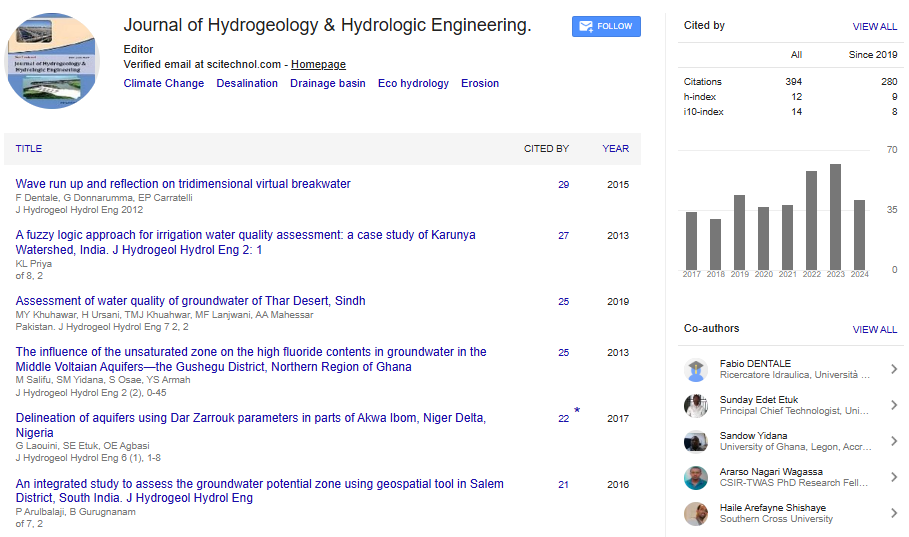Short Communication, J Hydrogeol Hydrol Eng Vol: 13 Issue: 6
The Dynamics of Infiltration in Hydrology
Hanako Mori*
1Department of Ecohydrology, University of Bologna, Bologna, Italy
*Corresponding Author: Hanako Mori,
Department of Ecohydrology, University of
Bologna, Bologna, Italy
E-mail: morih467@gmail.com
Received date: 26 November, 2024, Manuscript No. JHHE-24-154130;
Editor assigned date: 28 November, 2024, PreQC No. JHHE-24-154130 (PQ);
Reviewed date: 12 December, 2024, QC No. JHHE-24-154130;
Revised date: 20 December, 2024, Manuscript No. JHHE-24-154130 (R);
Published date: 27 December, 2024, DOI: 10.4172/2325-9647.1000360.
Citation: Mori H (2024) The Dynamics of Infiltration in Hydrology. J Hydrogeol Hydrol Eng 13:6.
Description
Infiltration is a precarious process in the hydrological cycle, governing the movement of water from the surface into the soil. It plays a significant role in replenishing groundwater, maintaining soil moisture and reducing surface runoff. The dynamics of infiltration are influenced by various factors such as soil characteristics, vegetation cover, land use and rainfall intensity, making it a vital topic in environmental science, agriculture and water resource management.
Infiltration begins when water from precipitation or irrigation interacts with the soil surface. The soil acts as a porous medium, allowing water to penetrate and percolate through its layers. The rate at which this occurs is called the infiltration rate, typically measured in millimeters per hour. Initially, the infiltration rate is high due to dry soil conditions, but it decreases over time as the soil becomes saturated [1-3].
Factors influencing infiltration
Several factors impact the rate and extent of infiltration:
Soil properties: Texture, structure and porosity significantly affect infiltration. Sandy soils with large pores allow quicker infiltration compared to clayey soils, which have smaller pores and higher compaction.
Soil moisture content: Pre-existing moisture reduces the soil’s ability to absorb additional water, lowering the infiltration rate.
Vegetation: Plant roots create channels in the soil, enhancing infiltration. Additionally, vegetation intercepts rainfall, reducing the direct impact of water on the soil and preventing crust formation.
Land use and management: Urbanization and agricultural practices can alter infiltration rates. Impervious surfaces like concrete prevent infiltration, leading to increased runoff, while conservation practices such as no-till farming and contour plowing promote infiltration.
Rainfall characteristics: The intensity and duration of rainfall influence infiltration. High-intensity rain may exceed the soil’s infiltration capacity, causing surface runoff, while moderate rainfall allows for better absorption.
Measurement and modeling
Accurate measurement of infiltration is essential for effective water resource management. Common methods include the use of infiltrometers, rainfall simulators and field observations. Mathematical models, such as the Green-Ampt model and the Horton infiltration equation, are employed to predict infiltration rates under various conditions. These models aid in designing irrigation systems, flood control measures and soil conservation practices [4-7].
Applications and importance
Understanding infiltration is essential for several practical applications:
Groundwater recharge: Infiltration is the primary mechanism for replenishing aquifers, which serve as vital sources of freshwater.
Flood modification: By reducing surface runoff, infiltration lowers the risk of flooding in urban and rural areas.
Soil conservation: Promoting infiltration helps prevent soil erosion by stabilizing the topsoil and minimizing waterlogging.
Agricultural productivity: Adequate infiltration ensures the availability of water for crops, supporting sustainable farming practices.
Despite its significance, infiltration faces challenges in many regions. Urbanization and deforestation have drastically reduced infiltration capacity, leading to issues like water scarcity, soil degradation and increased flooding. Climate change further improves these challenges by altering rainfall patterns and intensifying extreme weather events.
Future research should focus on developing advanced models to predict infiltration under varying climatic and land-use scenarios. Adopting sustainable land management practices, such as afforestation, rainwater harvesting and green infrastructure, can enhance infiltration and moderate its associated challenges [8-10].
Conclusion
Infiltration is more than a simple hydrological process; it is a cornerstone of water sustainability and environmental health. By recognizing its role and addressing the factors that influence it, we can better manage water resources, protect ecosystems and build flexibility against climate-related impacts.
References
- Toosi G (2023) Influence of vegetation in the flood drainage ditch. J Civ Eng Res 5(4): 16-21.
- Barazzetti L, Banfi F (2017) BIM and GIS: When parametric modeling meets geospatial data. ISPRS Ann Photogramm Remote Sens Spat Inf Sci 4: 1-8.
- Chapman AR (2002) The human rights implications of intellectual property protection. J Int Econ Law 5(4): 861-882.
- Deng Y, Fu B, Sun C (2018) Effects of urban planning in guiding urban growth: Evidence from Shenzhen, China. Cities 83:118-28.
- Zhang KM, Wen ZG (2008) Review and challenges of policies of environmental protection and sustainable development in China. J Environ Manage 88(4): 1249-1261.
[Crossref] [GoogleScholar] [Pubmed]
- Singh VP (2018) Hydrologic modeling: progress and future directions. Geosci lett 5(1): 1-8.
- Hall JW, Boyce SA, Wang Y, Dawson RJ, Tarantola S, et al. (2009) Sensitivity analysis for hydraulic models. J Hydraul Eng 135(11): 959-969.
- Baker TR (2005) Internet-based GIS mapping in support of K-12 education. Prof Geogr 57(1): 44-50.
- Tayefi V, Lane SN, Hardy RJ, Yu D (2007) A comparison of one‐and two‐dimensional approaches to modelling flood inundation over complex upland floodplains. Hydrol Process Int J 21(23): 3190-3202.
- Leyden KM, Slevin A, Grey T, Hynes M, Frisbaek F, et al. (2017) Public and stakeholder engagement and the built environment: A review. Curr Envir Health Rpt 4: 267-277.
[Crossref] [GoogleScholar] [Pubmed]
 Spanish
Spanish  Chinese
Chinese  Russian
Russian  German
German  French
French  Japanese
Japanese  Portuguese
Portuguese  Hindi
Hindi 
